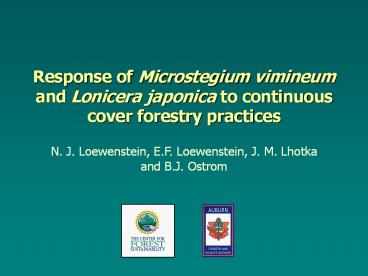Vegetation analysis PowerPoint PPT Presentation
Title: Vegetation analysis
1
Response of Microstegium vimineum and Lonicera
japonica to continuous cover forestry practices
N. J. Loewenstein, E.F. Loewenstein, J. M. Lhotka
and B.J. Ostrom
2
Microstegium vimineumNepalese browntop, Japanese
stiltgrass, Marys grass
- Annual C4 grass
- Shade tolerant
- Shallow roots
- Mesic soils
- Most of eastern US
- Class C noxious weed in Alabama
3
Lonicera japonica Japanese honeysuckle
- Semievergreen to evergreen woody vine
- Shade tolerant
- Tolerates a wide range of site conditions
- Most of US
- Ornamental and deer browse
4
Background
- Silviculture study looking at forest management
options for private landowners at the urban-rural
interface - Continuous cover forest management
- Promote the continued establishment and
development of tree reproduction
5
Silviculture study objectives
- Apply gradient of cutting regimes.
- Quantify the relationship between residual forest
structure and understory microclimate (especially
light). - Assess the relationship between the understory
environment and seedling growth response.
6
(No Transcript)
7
- Quantifying Forest Environment
- Vertical and horizontal structure
- Understory microclimate
- Assessing Relationships Between
- Canopy structure and light transmittance
- Canopy structure and development of planted
cherrybark oak, yellow poplar, and water oak
seedlings - Canopy structure, light transmittance and growth
of Microstegium and Lonicera
8
- Fifty 0.05 ha plots in riparian hardwood forest
- Structural manipulations
- Control No trees cut
- Light cut 1/3 of all midstory trees cut
- Moderate cut 1/2 of all midstory trees cut
- Heavy cut all midstory trees cut
Uncut
Heavy cut
9
Gradient in forest structure
10
Light regimes in four representative plots
11
Methods
- Biomass
- Percent cover - 1 m2 plots (spring and late
summer) - Clip plots (late summer)
- Photosynthesis
- Photosynthetic light curves
- Fecundity
- Clip plots (after seed set)
12
Above-ground biomass
13
(No Transcript)
14
Photosynthetic Light Curves
15
- Chasmogamous flowers - flowers that open,
exposing stamens and styles to the environment
allowing potential cross-pollination - Cleistogomous flowers - flowers that do not open
and are self-pollinated
16
Microstegium fecundity
17
Conclusions
- Microstegium was more responsive than Lonicera to
the moderate increase in light. - First year results may not fully reflect the
potential impact of Lonicera. - Herbicide treatments may be required.
18
Acknowledgements
- Field site Blanton Creek Wildlife Management
Area, Georgia Power and Georgia DNR - Field and lab assistance Gayla Trouse
- Funding Center for Forest Sustainability,
- Auburn University
19
Questions?

